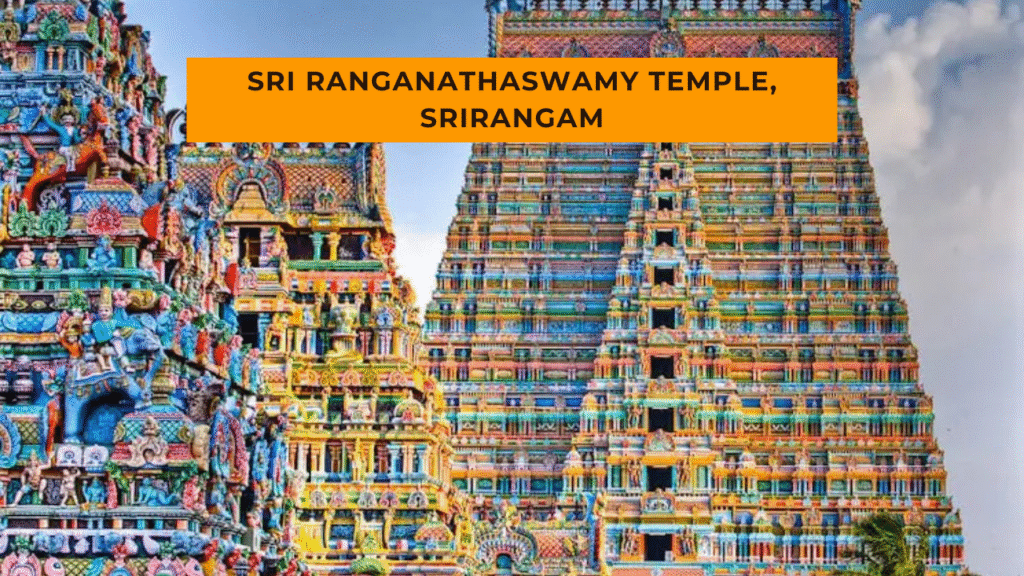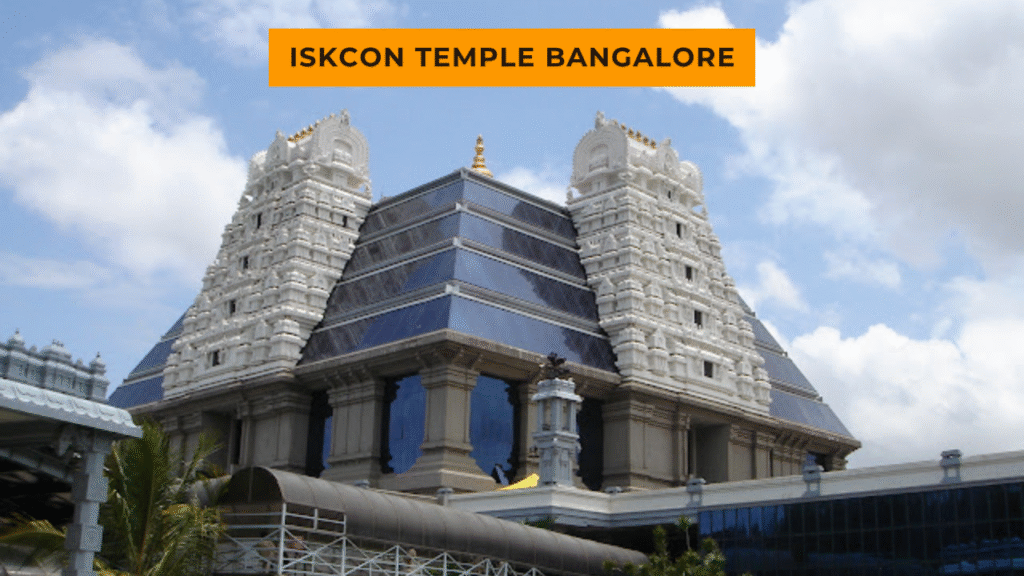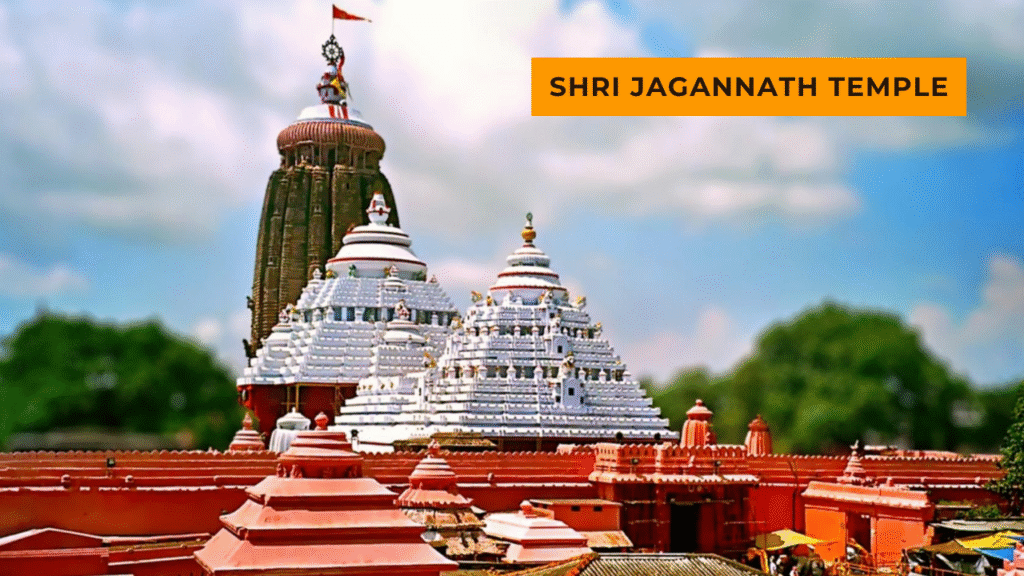The ‘Srirangam Temple’, also known as ‘Sri Ranganathaswamy Temple’, is located on the Srirangam Island in Tiruchirappalli, Tamil Nadu. It is one of the largest temple complexes in the world and is dedicated to ‘Lord Ranganatha’, a reclining form of ‘Lord Vishnu’. Revered as the first and foremost of the 108 Divya Desams (sacred Vishnu temples), it is an architectural marvel and a significant spiritual center for Vaishnavites.
Mythological Origins and Significance
1. The Idol of Ranganatha: According to legend, the idol of Ranganatha was originally worshiped by Lord Brahma in Satya Loka (the celestial world). It was later gifted to King Ikshvaku, an ancestor of Lord Rama, and subsequently passed down through the Ikshvaku dynasty.
2. Connection with Lord Rama: After the defeat of Ravana, Lord Rama is said to have gifted the idol to Vibhishana, Ravana’s virtuous brother. While Vibhishana was carrying the idol to Lanka, it is believed to have been placed temporarily on the banks of the Kaveri River at Srirangam. The idol became immovable, and Lord Ranganatha chose Srirangam as his eternal resting place.
3. Vaikuntha on Earth: The temple is considered an earthly manifestation of Vaikuntha, Lord Vishnu’s celestial abode. It is believed that worshiping at Srirangam grants liberation (moksha).
Historical Background
1. Sangam Period (3rd Century BCE–3rd Century CE): References to Srirangam are found in Tamil Sangam literature, including works like the ‘Silappatikaram’. This period highlights the temple’s existence as an important cultural and religious center.
2. Early Chola Period (9th–10th Century): The Cholas were great patrons of the Srirangam Temple. Kings like ‘Aditya Chola’ and ‘Raja Raja Chola I’ contributed to its expansion and enriched its architecture. The temple became a significant hub for Tamil Vaishnavism during this era.
3. Hoysala Period (12th Century): The Hoysalas supported the temple and contributed sculptures and architectural additions. The temple continued to thrive under their patronage.
4. Muslim Invasions (14th Century):
- During the invasion of ‘Malik Kafur’ in 1311 and subsequent raids, the temple suffered significant damage. To protect the idol of Ranganatha, the temple priests hid it in the hills of Tirupati for over 60 years.
- The Vijayanagara rulers later restored the temple, and worship was resumed.
5. Vijayanagara Empire (14th–16th Century): The Vijayanagara kings played a pivotal role in reconstructing and revitalizing the temple after the invasions. They made significant contributions to its architecture, including the addition of gopurams (towers).
6. Nayaka and Maratha Periods (16th–18th Century): The Nayaka rulers of Madurai and the Marathas further contributed to the temple’s artistic and cultural development.
Architectural Features
The Srirangam Temple is a magnificent example of Dravidian architecture and is renowned for its sheer scale and intricate craftsmanship.
1. Temple Complex: Spanning over 155 acres, it is one of the largest temple complexes in the world. It consists of ‘seven concentric enclosures’ (prakarams) and 21 monumental gopurams (towers).
2. Raja Gopuram: The ‘Raja Gopuram’, standing at 236 feet, is the tallest temple tower in India. Completed in 1987, it is a stunning example of engineering and artistic excellence.
3. Garbhagriha (Sanctum Sanctorum): The sanctum houses the idol of Lord Ranganatha in a reclining posture on the serpent Adishesha, with the divine consort Goddess Lakshmi (Ranganayaki) at his feet.
4. Hall of 1,000 Pillars (Ayiram Kaal Mandapam): This intricately carved hall is an architectural masterpiece, featuring sculptures of horses, warriors, and deities.
5. Sacred Water Tank (Chandrapushkarani): The temple has a sacred tank where devotees perform rituals before entering the sanctum.
6. Golden Vimana: The sanctum’s roof (vimana) is covered in gold, symbolizing the divine nature of Lord Ranganatha.
Religious Significance
1. First of the 108 Divya Desams: The temple is considered the holiest of the Divya Desams and is mentioned in the hymns of the ‘Alwars’, the Tamil saint-poets of Vaishnavism.
2. Pancharanga Kshetra: Srirangam is the foremost of the five Pancharanga Kshetras (sacred sites along the Kaveri River) dedicated to Lord Ranganatha.
3. Vaishnavite Center: The temple played a central role in the development of ‘Sri Vaishnavism’, particularly under the guidance of ‘Ramanuja’, the great Vaishnavite theologian.
Festivals and Rituals
The Srirangam Temple celebrates numerous festivals throughout the year, with grand rituals that attract thousands of devotees.
1. ‘Vaikuntha Ekadashi’: This is the most important festival at Srirangam, celebrated during the Tamil month of Margazhi (December-January). It marks the opening of the ‘Paramapada Vasal’ (Gateway to Heaven), symbolizing entry into Vaikuntha.
2. ‘Rathotsavam (Chariot Festival)’: The temple hosts a grand procession where the deity is paraded in a beautifully decorated chariot.
3. ‘Panguni Uthiram’: This festival celebrates the divine marriage of Lord Ranganatha and Goddess Ranganayaki.
4. ‘Adhyayanotsavam’: A 21-day festival involving the recitation of ‘Divya Prabandham’, the Tamil hymns of the Alwars.
Role of Ramanuja
‘Sri Ramanuja’ (1017–1137 CE), the great Vaishnavite philosopher, played a pivotal role in the spiritual and administrative revival of the temple:
1. Leadership: Ramanuja became the temple’s spiritual head and implemented systematic administrative reforms.
2. Social Inclusivity: He ensured that people from all castes had access to the temple and the teachings of Vaishnavism.
3. Shrine: A shrine dedicated to Ramanuja within the temple complex enshrines his ‘mummified body’, which is revered by devotees.
Modern Importance
The Srirangam Temple remains a vibrant center of worship and cultural heritage:
1. UNESCO Recognition: It has been considered for inclusion in the UNESCO World Heritage Sites list due to its architectural and cultural significance.
2. Pilgrimage: The temple is a must-visit for Vaishnavites and Hindu devotees worldwide, offering spiritual solace and divine blessings.
3. Tourism and Conservation: The temple attracts millions of visitors annually, and efforts are ongoing to preserve its rich heritage.
Legacy
The Srirangam Temple is not just a place of worship but a symbol of the enduring legacy of Indian spirituality, architecture, and culture. Its history of resilience, devotion, and grandeur makes it one of the most remarkable temples in the world.



